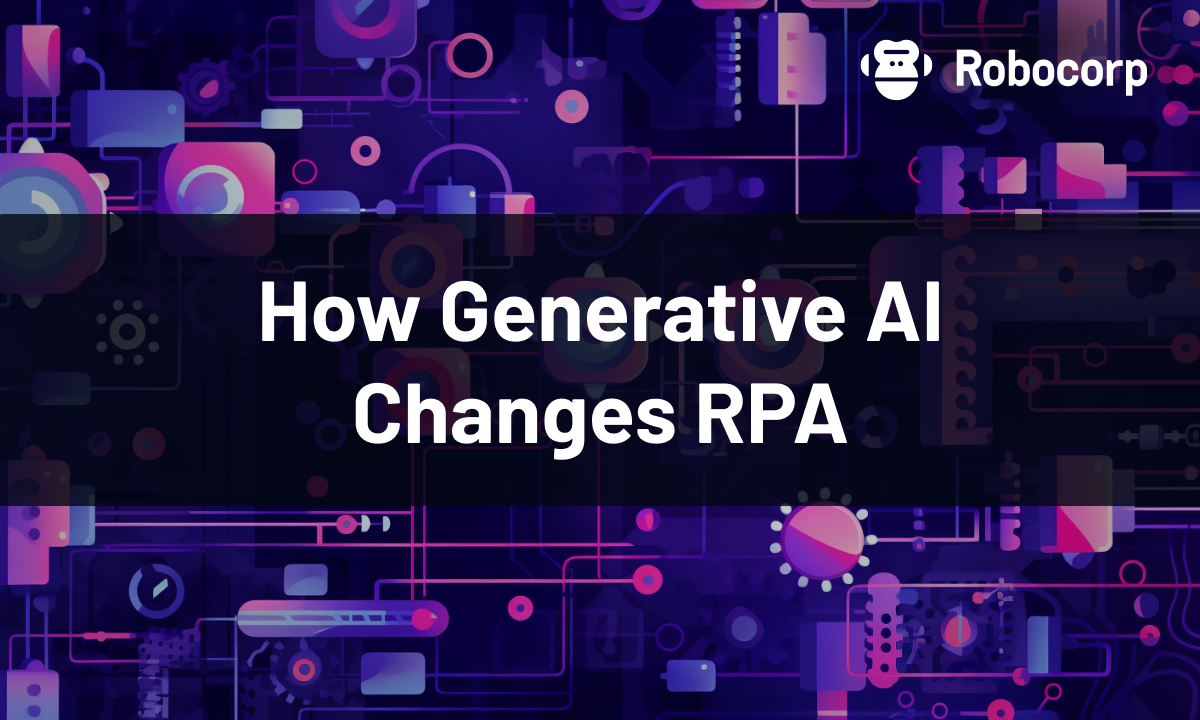How Generative AI Changes RPA
Generative AI is transforming the RPA landscape, opening new possibilities for automation and redefining our approach to building bots. Its integration with existing RPA practices leads to faster, more efficient, and more intelligent automation processes.

The landscape of Robotic Process Automation (RPA) has evolved over the past five years from low impact desktop automation to mission critical back-office integration and business process platform. Now we are seeing a new wave of evolution in RPA as Generative AI is entering the playing field.
RPA is becoming the access route for deploying AI into enterprise IT systems. We have to rethink if “Robotic Process Automation” is anymore even the right term for this technology or should we talk about automation through bots / digital assistants instead.
This isn’t about a wild future vision either, but something that’s happening right now. Here are the emerging trends that Generative AI brings to the world of enterprise automation today.
Generative AI is Replacing Low-Code
Low-code has been a big hit in enterprise for a good reason. It removes what we describe as the “blank canvas problem”. When your world is limited to a finite set of actions, composing an initial solution is easier and you don’t have to be an expert with the tool to get started.
However, going beyond simple demos becomes increasingly difficult as you have to layer in error handling and more complex logic. Soon you will find yourself coding in a limited restrictive framework and thinking “why are we doing this in low-code in the first place”. Not to even mention scaling your solution out to hundreds of complex mission critical automations.
Generative AI is the perfect solution for getting over the blank canvas problem with actual code. You can prompt AI to create your script and collaboratively work together on fine-tuning it. No expert software engineering skills needed and you will have the full power and flexibility of a scripting language such as Python at your disposal. We have already seen people with little to no programming skills building complete web applications with the help of Generative AI. Now this is coming to change RPA and automation as well.
Low-code / no-code is great for problems with very limited scope, but in the world of automation and bots, we are calling an end to these beautiful handcuffs that trade off too much against an initial wow effect. Let’s have AI handle that for us instead.
New Automation Skills with Generative AI
Generative AI is not just about simplifying coding. It brings with it new skills and capabilities to automation itself.
With zero-shot learning, Generative AI eliminates the need for large training datasets. Its ability to perform tasks such as classification and natural language processing (NLP) extraction without any learning data aligns perfectly with the RPA ethos, facilitating much faster deployment with less effort.
Moreover, bots are no longer limited to back office work – with text generation they can now engage in outbound communication with stakeholders. This will require a human in the loop to make sure that messages are aligned but it’s still very powerful addition to bot capabilities.
AI isn’t limited to public information or the training cutoff date either. Retrieval-augmented Generation (RAG) can be used to ground AI generated content to your own documents and business context. Securely available LLMs, such as Azure OpenAI, combined with easy to deploy vector databases is lowering the entry barrier here significantly.
The Ideal Tech Stack for Delivering AI + Automation
When it comes to the technology stack, Python reigns supreme in the world of AI and automation. LLMs are fluent in Python, and every application and technology has a Python library that allows connecting and interacting. In browser automation, the Playwright project stands out as the most modern and powerful tool.
Robocorp has developed extensive open-source tooling to make it as simple as possible to build and package Python automations in a way that they can repeatably run in any new environment without installation and portability hassles. All this is free to use for everyone.
On top of the bot itself, when we talk about enterprise usage, security and governance is on top of everyone’s mind. Orchestrating bots and data is also a challenge that needs to be solved. This is where Robocorp Control Room comes into play. Its aim is to make deploying Python automation easy, secure, and seamless while providing great data connectivity across systems.
Conclusion
Generative AI is transforming the RPA landscape, opening new possibilities for automation and redefining our approach to building bots. Its integration with existing RPA practices leads to faster, more efficient, and more intelligent automation processes.
As we have entered this new era, now is the time to re-evaluate how companies of the future automate their business processes. This is also the perfect opportunity to move your automation program to a modern architecture and leverage the fastest growing open software ecosystem that ensures you will have access to the latest innovations in the years to come.
